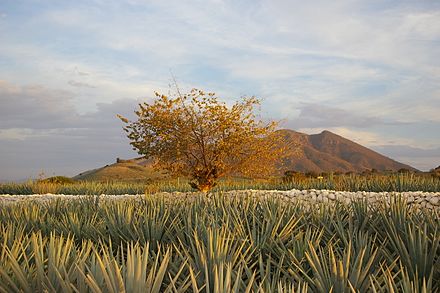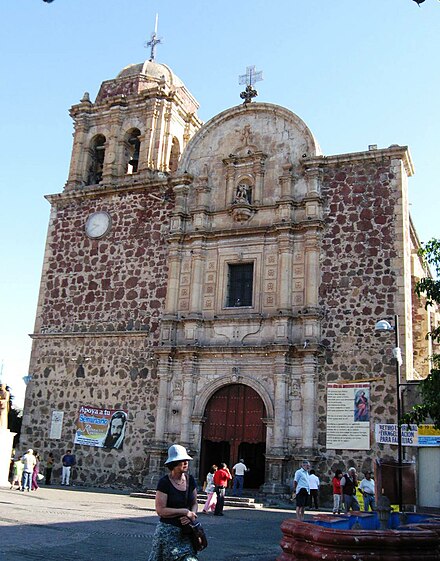Tequila - city of Jalisco State, Mexico
Tequila is a municipality in Jalisco, Mexico, near Guadalajara. It is famous for being the birthplace of the eponymous tequila liquor. Its distilleries offer tours of the fabrication process and into the fields where the agave plant, from which it is made, is grown.
Understand
 The beverage called tequila is really a variety of mezcal, made wholly or mostly from the blue agave plant. This plant is native to the Tequila area so this version of mescal was named after the town.
The beverage called tequila is really a variety of mezcal, made wholly or mostly from the blue agave plant. This plant is native to the Tequila area so this version of mescal was named after the town.
Tequila is made from the blue agave plant, native to this area. The heart of the plant contains sugars and had been used by native peoples here to make a fermented drink. After the Spanish arrived, they took this fermented beverage and distilled it, producing the tequila known today. The "Agave Landscape and Ancient Industrial Facilities of Tequila" has been inscribed on the UNESCO World Heritage list.
.jpeg/440px-A_Side_Street_(231393503).jpeg) A surprising tradition is the nightly blessing of the town by the parish priest. At 21:00 every night, the priest offers blessings by ringing a bell three times, and directing the holy of holyest cross with the sacraments towards all 4 cardinal points. At this moment, everyone in the town stops what they are doing, including turning off things like the television or radio and stands for the blessing.
A surprising tradition is the nightly blessing of the town by the parish priest. At 21:00 every night, the priest offers blessings by ringing a bell three times, and directing the holy of holyest cross with the sacraments towards all 4 cardinal points. At this moment, everyone in the town stops what they are doing, including turning off things like the television or radio and stands for the blessing.
The city was home to 29,000 people in 2010.
Get around
Walking
Tequila is a small town, so you can visit most distilleries and locations within a 15-minute walk from the town square.
Taxi
If you need to get anywhere farther (e.g., the Balnearo La Toma or the Cascadas Los Azules), it's possible to take a taxi. Taxis pick up from the corner of |Sixto Gorjón and Santos Degollado
Get in
By bus
- Terminal de Autobuses de Tequila, C. Francisco I. Madero 156, 20.8817344°, -103.8356076°.
The bus from Guadalajara leaves regularly from the Central Camionera Vieja (Old Bus Station) near the center of that city. MX$220 one-way and MX$420 round-trip (Dec 2022). From the bus station, it's a short walk from there to the town center.
By car
From Guadalajara, take the main autopista towards Puerto Vallarta and turn towards Tequila once outside Guadalajara. Travel time should be no more than an hour.
By train
Every Saturday, the Tequila Express departs from the train station in Guadalajara en route to Tequila, taking weekend day trippers to see the famous agave fields and distilleries that make Mexico's most famous liquor. Along the way, tequila samples are tasted, mariachis play soulful tunes, and the crowd arrives in Tequila ready to tour the Sauza distillery and take a deep dive into tomorrow's hangover.
Get around
The town is small enough to walk around. All the major attractions (town square, church, distilleries) are within spitting distance of each other.
See

- Our Lady of the Purísima Concepción. Open every day. It was built in the 18th century by Martín Casillas. The church has a stone facade, a bell tower and inverted truncated pyramid (estipite) pilasters that flank the main portal. The portal has two levels and a crown. The first level contains the door arch with has moulding and a seal and is supported by two Doric columns. The upper portion contains a window with moulding with Doric columns in each side, decorated with curves and vegetable motifs. The crown at the top contains a sculpture of the Archangel Michael in a niche flanked by Doric columns. The side portal is an arched entrance with Tuscan columns and cornice and a cross in relief at the midpoint. Inside are one nave and a Neoclassical main altar. 2021-09-04
- Main Plaza, has a bandstand and monuments to Mexican heroes.
- José Cuervo Distillery, First tequila manufacturer. Offers a range of tours, from the 'Clásico' which is about M$100 (pesos), up to M$380. The more expensive ones generally just include extra tasting sessions, except for the most expensive one which also has a tour of the fields where the agave plant is grown.
- The National Museum of Tequila (MUNAT)
Do
- The National Tequila Fair is held every year from the end of November to the middle of December. During this event, a Tequila Queen is crowned and the main distillers in the area all have a presence with samples of their tequila. There are also charreada events and a parade with floats, cockfights, mariachis, fireworks and rides. This festival coincides with the feast of Tequila's patron saint, Our Lady of the Purisíma Concepción.
- Take a walk, The countryside outside the town is lovely to walk through and you can visit the agave plants without having to take a tour.
- You can rappel in seasonal waterfalls, hike to the Cascade of the Azules, and watch birds.
Buy
Tequila obviously, there are a number of shops on the way to and from the bus station which have various selections. Generally the tourist shops all carry the same things, shot glasses, tequila sets (bottle of tequila and five or so glasses), souvenir barrels and t-shirts. Most of which can be found in other places including Guadalajara.
In Tequila, almost all the t-shirts contain the word 'Tequila, Puebla Mágica'(magic village) or a variation, even if the picture on the image is unrelated to tequila, e.g. a picture of Che Guevara or Mexican film legend Pedro Infante.
Eat
There are plenty of restaurants and food stands around the centre. Most will only have typical Mexican food, but many have a wider selection. Almost the ones where you can sit down will have a wide variety of tequila and other alcoholic drinks. Typical Mexican prices.
There is a great variety of seasonal fruits such as ovo, which is a fruit that only grows in this place.
Street food
- Callejon Del Hambre, Agustina Ramírez 16, 20.8843861°, -103.8381664°. 2022-05-01
Food markets
- Mercado de Comidas "Cleofas Mota", José María Morelos, 20.8846460°, -103.8382962°. 2022-09-01
Budget
- Cenaduria "La Chata", Gral. Arteaga 98, 20.8845170°, -103.8349152°. 2022-09-01
- Tacos Pelliscadas y Quesadillas Boti La Capilla, Hidalgo 34, 20.8826209°, -103.8398089°. 2022-09-01
- Gorditas "La Mata", López Mateos, 20.8831735°, -103.8329804°. 2022-09-01
- Fonda Mago, C. Luis Navarro 21, 20.8835995°, -103.8398304°. 2022-09-01
- Fonda La Martina, C. Albino Rojas 16, 20.8853139°, -103.8389389°. 2022-09-01
- Rosticería Rico el Pollo, Niños Heroes 55, 20.8846439°, -103.8373953°. 2022-05-01
Mid-range
- El Palomar, Vallarta 2, 20.8841257°, -103.8385258°. 2022-09-01
- Pizzería El Tejaban, Jesús Rodríguez de Hijar 25, 20.8843920°, -103.8395306°. 2022-09-01
- La molleteria, Abasolo 59, 20.8842927°, -103.8370982°. 2022-09-01
Splurge
- La Antigua Casona, C. Albino Rojas #14, 20.8852221°, -103.8388061°. 2022-09-01
Drink
If you're here, you're here to drink tequila. It's sold everywhere. Any place that doesn't sell it is probably giving away free samples.
Sleep
Number of hotels in the centre.
- Nueve Agaves, Francisco Javier Sauza Mora 21, Tequila, 20.883603°, -103.839685°, +52 374 688 03 96, contacto@nueveagaveshotel.com.mx. Check-in: 15:00, check-out: 12:00. Comfortable boutique hotel with affordable rates. M$1200 2022-11-30
- Casa Salles, C. la Villa 3, 20.881565°, -103.845356°, +52 3746880388. Check-in: 15:00, check-out: 12:00. Modern brick building on outskirts of town. Clean, modern. Swimming pool available. Next to El Tequilino distillery, 10 minute walk to town center. 2022-11-30
- Hotel Plaza Jardin, José Cuervo 13, La Villa, 20.884872°, -103.838908°, +52 3747420061. Check-in: 14:00, check-out: 12:00. Small, colonial style hotel overlooking the Plaza Principal (town square). 1 minute walk to Tequila Museum. 2022-11-30
- Hotel Plaza Rubio, Hidalgo 100, 20.881394°, -103.840058°, +52 3747423399. Check-in: 15:00, check-out: 12:00. Modest hotel, 5 minute walk to town center. 2022-11-30
- Casa Hotel la Gran Senora, Nicolás Bravo No. 72, 20.881745°, -103.837858°, +52 3747423300. Check-in: 15:00, check-out: 12:00. Traditional style hotel with comfortable rooms surrounding a tranquil central courtyard. 2022-11-30
Connect
Go next
Tequila
tequilajalisco.gob.mxPostal code:46400−46404Date Time:Please wait...Timezone:America/Mexico_CityPopulation:31,115Coordinates:20.88, -103.84
Tequila
2nd-order administrative division
Jalisco
Primary administrative division